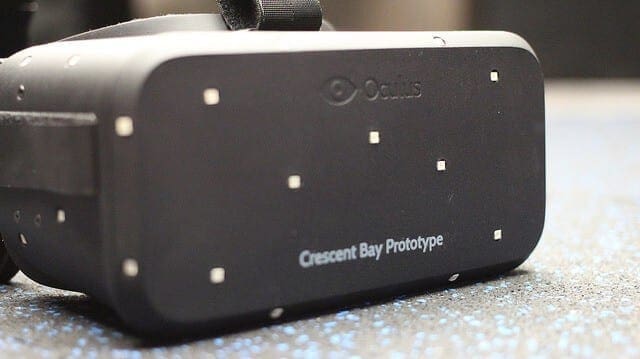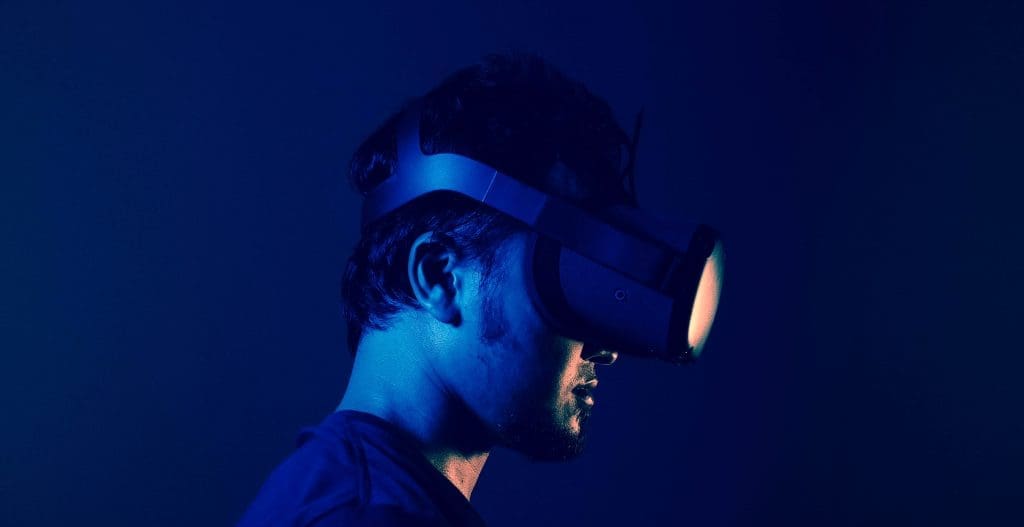Editor’s note: We posted the below article back in 2016 covering the history of virtual reality and its rise in popularity for both gaming and businesses alike. We thought it would be useful to take a look at how things have changed in the years since 2016. In this edition, we will look at the exciting future of VR in 2022 and beyond, including how the metaverse and virtual reality are so closely intertwined.
— Original article from 2016 (to include minor changes to improve accuracy) —
Is virtual reality a new topic?
- 1 Is virtual reality a new topic?
- 2 History of virtual reality: the early years
- 3 Virtual reality timeline infographic
- 4 The rise of VR: what came next?
- 5 Current VR: virtual reality is now a hot topic
- 6 A short modern History of VR — 2016 to 2022
- 7 Metaverse vs virtual reality
- 8 The Future of VR — 2022 Onwards
Despite ‘virtual reality’ now gaining its rightful place as one of the hottest buzzwords in the tech and business worlds, it is not a new concept.
In fact, the beginnings of virtual reality date back to the 1950s when a group of visionaries believed in the possibility of viewing images on a limitless, boundary-less screen. However, at the time the technology and the visuals weren’t competent enough and so the concept remained only a dream. It stayed this way for many years, despite some small military interventions where they began using virtual reality technology for effective war training simulations.
By the 1980s and 1990s, the concept had once again been reborn with a lot more strength, albeit it was mostly in films such as The Matrix, Virtuosity, The Lawnmower Man and Strange Days.

The Lawnmower Man – image credit: Pinterest
While it eventually fell again in this period, it is now undergoing yet another re-rising, with the exception being that this time it now seems somewhat unstoppable, with the virtual reality and augmented reality industries expected to be worth $150 billion by 2020.
History of virtual reality: the early years
The history of virtual reality is interesting, as true virtual reality is no easy feat; you’re attempting to transport the user into a whole new experience, plucking them out from their current one. Of course, they know it’s only virtual, but companies that can make users forget this, even for just a second, will be the ones that push ahead in the market.
It’s no surprise then that virtual reality never took off in the 1950s. As the world has only just recently become familiar with 3D screens and Blu-ray technology, the hardware and software simply didn’t exist previously to take virtual reality from fantasy to reality. The closest anyone came in this period was in 1962 when Mort Heilig patented the Sensorama, which was a cabinet with a 3D display, vibrating seat and a scent producer.

In 1962 Heilig patented the Sensorama – image credit: Wikipedia
Some would even argue that the concept of virtual reality predates the 1950s, with 360-degree murals (panoramic paintings) and stereoscopic photos and viewers of the nineteenth century, or the first flight simulator in 1929. Regardless of when the concept of virtual reality began, it’s clear that people know that an audience wants to be transported out of their current experience to a new one, which is why films like Avatar were so successful.
A small minority of inventors returned to the concept of virtual reality in the 1980s and 1990s after its failures three decades before this. The personal computer was becoming mainstream, and many of Hollywood’s biggest blockbusters were using computer-generated special effects to give viewers a new experience in the cinema. Alongside this, arcade headsets, sensor-equipped gloves, and full-body motion tracking suits had also been released. Could these inventors make use of this new technology? Unfortunately not. The technology remained lacklustre when trying to achieve a vision for virtual reality, and while users could experience a rough version of an alternative reality, the actual experience, and the concept, were still a world apart. It was also costly, both in terms of time and money.
This was shown when The National Center for Supercomputing Applications, based in the U.S., produced an award-winning animation of smog descending upon Los Angeles, which showed the breadth of what could potentially be achieved with animations and virtual reality. But, it took six months to produce this animation, and it couldn’t be changed once it was finished. People, whether this is in the military, in businesses or the gaming industry, wanted interactivity with their virtual reality. With this in mind, the virtual reality industry in the 1990s all but died, yet again. Instead, it was replaced by a more exciting, and more realistic concept; the internet.
Virtual reality timeline infographic
Here’s an excellent timeline of VR in an infographic from http://www.tomshardware.co.uk:

Virtual reality timeline from Tom’s Hardware
The rise of VR: what came next?
The Oculus Rift headset
It wasn’t a ‘what’ so much as a ‘who’. Palmer Luckey, using much-improved technology, raised enough funding to establish the now well-known Oculus. Now they’re one of the industry leaders in virtual reality with their Oculus Rift headset. Our chief technical guru Rob was one of the early adopters of the Oculus Rift and previously blogged about his experiences using the technology back in 2014. At this time it was clear that the virtual reality industry still had some way to go but for the first time ever virtual reality could be experienced properly.

The Oculus Rift headset – image credit: Maurizio Pesce
Facebook acquisition of Oculus
What could take Oculus from where it was to where it needed to be? A $2 billion acquiring deal from Facebook was to be the answer and suddenly Oculus became a household name, and virtual reality became the next ‘big thing’.
With the $599 Oculus Rift headset, it was clear that virtual reality was here to stay. The groundwork for virtual reality had been laid over a number of decades, all it needed was an entrepreneur with a vision to put all of the different pieces together. With the help of researchers such as Skip Rizzo, who had been using virtual reality to help treat cognitive and motor illnesses, Luckey was able to achieve what visionaries had been trying to for many years.
It was in 2000 that you could achieve some form of virtual reality on a PC. Then from 2002, other innovations which showed promise were brought to the public eye, such as the Wide Five display in 2006 which allowed for a much wider field of view than was previously available. In 2009, Luckey started to bring all of this research together. At the time, not even he, Rizzo or Mark Bolas, a researcher from the Institute for Creative Technologies who was also assisting in the production, could have predicted the success that virtual reality would achieve.
In fact, the night before they launched the Kickstarter campaign, Luckey said:
“Look, even if we sell 300 developer kits, that’s a huge success for VR. No one has gotten that many game developers interested in VR.” He later said, “it was kind of a silly worry in hindsight.”
Current VR: virtual reality is now a hot topic
Fast forward a few years and now Oculus has some serious competition. In fact, it appears they may not even be market leaders anymore.
With poor decisions such as moving their headset into retail stores before fulfilling all their current pre-orders, and the rise of suspected competitors such as Samsung, with their lower cost Samsung Gear VR as well as surprise entries such as the HTC Vive, the virtual reality industry is now booming. Before, it was only a few visionaries who were trying to make virtual reality mainstream, and now all the big players are involved. Competition breeds innovation and perfection, and these stats show that Oculus has been knocked off the top spot for expected revenue in 2016.
Why has virtual reality suddenly seen this dramatic rise?
As we’ve learnt by now, virtual reality is not a new concept, and people have been trying to bring it out to the public for at least sixty years; longer if you date its beginnings back to the 360-degree murals. Quite simply, it’s been about waiting for the right technology. The immersion that virtual reality can achieve is something that will always appeal to humans. It’s why we read books or watch films that bear no truth to our everyday lives; people like to be taken into new experiences that aren’t real.
The reason there have been several attempts at virtual reality is that the want for it has never died. Perhaps it’s simmered a little or dropped out of the public eye completely for periods, but human nature and virtual reality go hand in hand.
Innovation sometimes requires patience. While virtual reality may have been dismissed as a fantasy not so long ago, many are slow on the uptake of new technology. Who can forget Bob Metcalfe infamously predicting in 1995 that the internet “will soon go spectacularly supernova and in 1996 will collapse.” Now as humans, both young and old, we couldn’t imagine a life without the internet (and Opace would have never been born!).
It looks as though virtual reality is heading in the same direction. It’s taken many, many years to get to the stage that it’s at now, but it’s clear that it’s only going one way. While simpler predictions, such as that virtual reality will now permanently be in the consumer market, now seem obvious, there are other high hopes for virtual reality such as its ability to treat mental health issues.
It’s clear that not only has it now moved away from the idea that it’s simply the next stage of gaming, but that it is witnessing a dramatic re-rising which is only going to continue going up. The only question now is which VR provider will win the race to become the dominant player, a question that we examine here.
This article is part of our series of articles below on “VR for business“:
- The History, Rise & Fall of Virtual Reality
- Has Oculus Lost the First Generation of Virtual Reality to HTC
- How Marketers Can Use Virtual Reality
- Virtual Reality vs. Augmented Reality & the Applications for Business
- Open Source Virtual Reality and What This Means for Business
- Virtual Reality Web Design; Why Every Business Will Need to Factor VR into Their Digital Marketing
- Virtual Reality eCommerce & the Future of Online Shopping (vCommerce)
- The Lowdown from Our VR Gurus, Rob and Adam
We would love to encourage some discussion and debate around where this interesting and game-changing technology is heading, so please feel free to leave us a comment below or on social media and we’ll get back to you.
— Second edition in 2022 what’s changed since 2016 and the future of VR —
Editor’s note: It has been 6 years since we first published our article on the history, rise and fall of virtual reality. Below, we have decided to take a fresh look at this and see what has changed from 2016 to 2022. We’ll also provide our thoughts and ideas about the future of VR and how the metaverse and virtual reality will work together.
A short modern History of VR — 2016 to 2022
Even over a short 6 year time period, the history of virtual reality is fascinating.
New VR headsets and technologies
In the years following our initial article, a huge number of different VR headsets were released onto the market. We saw the likes of the Pimax 4K released at the start of 2017 as well as tethered headsets containing eye-tracking technology such as the Fove 0.
Many of these headsets were released with 1440p resolution, but many included an OLED screen along with eye-tracking technology which further enhanced the VR experience.
A few years later in 2019, standalone VR units such as the Oculus Quest were released. These headsets provided a great option for those that wanted to get into VR but didn’t have a computer that was powerful enough for VR applications.
Virtual reality becomes more cost-effective and practical
It is worth remembering that up until this point, not only were VR headsets expensive, but the computer hardware required to run the software was expensive too. This meant that in 2016, you needed to invest over £1,000 to be able to experience VR at the required 90 FPS. With the release of the Quest, you could just pay for the unit, and have everything you need to get started built-in.
Another attractive feature that came with the Quest was the ability to move around without being tethered to a PC. Part of the VR experience is being able to move freely and feel immersed in these worlds. Without chunky cables around your feet, the Quest solved these problems.
We have since seen the release of the Quest 2 with even more headsets on the horizon that promise to further enhance the VR experience.

Standalone VR headsets allow users to move around freely. Photo by Minh Pham on Unsplash
Metaverse vs virtual reality
During 2021 and 2022 there has been a lot of talk about the metaverse and what this is, so it would be amiss for us not to discuss the metaverse vs virtual reality in this update.
The metaverse could really push VR into a space where it becomes more viable and accessible to casual users, but how does it compare to more conventional VR experiences?
The metaverse can be thought of as persistent 3D worlds. Within these worlds, people or businesses can purchase land, and have highly interactive experiences.
Another way to think of the metaverse would be to think of the internet, but in a 3D space where real estate locations have the potential to be just as important as domain names.
In terms of how this will compare to virtual reality experiences that we’ve seen so far, there are a few key differences:
- Firstly, these worlds are persistent meaning they are continually hosted and exist even when you disconnect from the session.
- The main difference though is that previous VR experiences were ‘sealed off’ experiences that were made to do just one thing. For example, a horror game’s VR experience sets out to only work within the confines of it being a horror experience. The metaverse, however, hosts a number of different more organic experiences that can simultaneously exist under the metaverse ‘umbrella’.
The Future of VR — 2022 Onwards
The next few years will be very important when it comes to VR and virtual experiences. The future of virtual reality looks very promising with the increasing popularity of NFTs and the metaverse. More headsets are on the horizon such as the PlayStation VR2, Quest 2 Pro and Valve’s sequel to the Index. We can also expect to see more businesses factoring VR into their digital marketing through 2022.
One thing is for sure, VR isn’t going away anytime soon, and there has never been a better time for newcomers to dive in.
Editor’s Note: We think the future of VR is exciting with more and more possibilities and applications becoming available. What do you think? Please share your comments and thoughts below.






A great and informative post. The post on the history of virtual reality and its future is both informative and intriguing. It covers the development of VR technology from the past to present and provides insights on its potential future applications in various fields.
Thanks Luke, VR is definitely an exciting field right now. Along with AI, these two technologies feel as though they have the potential to change everything.